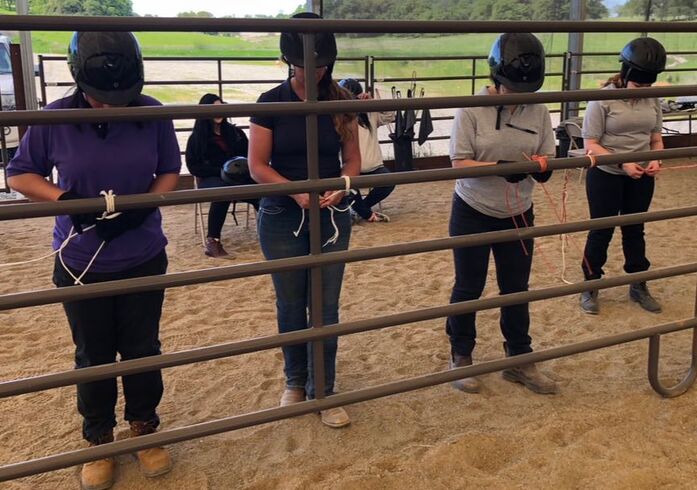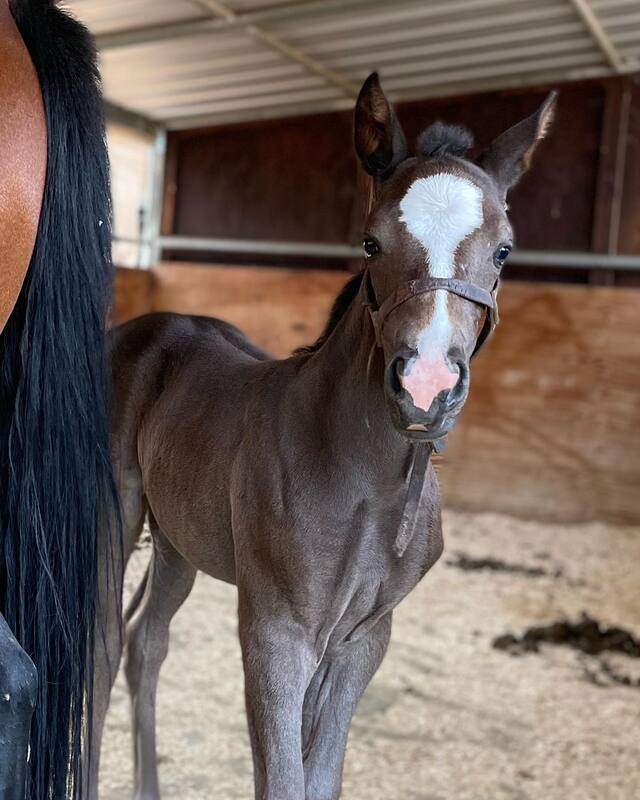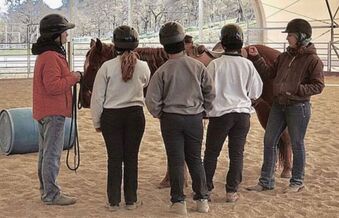|
Equine Assisted Learning is established through participants engaging in hands-on learning activities with the use of the horse as a partner to explore positive development of communications, self-respect, confidence, trust, accountability and conflict resolution. Sessions incorporate a variety of ground work and general horsemanship activities such as grooming, leading and herd observations. All activities are taught with outcomes focused on social, emotional and vocational skills used for healthy, healing and personal growth.
|
Children and adults, including veterans and active-duty military personnel, with physical, cognitive and emotional challenges find strength and independence through the power of the horse. |
All classes are overseen by a PATH Intl. Certified Equine Specialist who collaborate with mental health and learning specialists and community volunteers. All curriculum is developed with Learning Outcomes evidence through demonstration of the skill through strategy questions and practicums. Mental Health workers assist in processing specific issues that each participant may encounter while engaged in learning activities. |
Blue Oaks Center and PATH International
Blue Oaks Center is a nonprofit organization that promotes equine-assisted activities and therapies for individuals with special needs. We offer programs for Equine Assisted Learning following the PATH In'tl guidelines and our instructor is PATH certified (Professional Association of Therapeutic Horsemanship International [PATH Intl.]). Children and adults, including veterans and active-duty military personnel, with physical, cognitive and emotional challenges find strength and independence through the power of the horse.
Equine Assisted Learning is established through participants engaging in hands-on learning activities with the use of the horse as a partner to explore positive development of communications, self-respect, confidence, trust, accountability and conflict resolution. Sessions incorporate a variety of ground work and general horsemanship activities such as grooming, leading and herd observations. All activities are taught with outcomes focused on social, emotional and vocational skills used for healthy, healing and personal growth.
All classes are overseen by a PATH Intl. Certified Equine Specialist who collaborate with mental health and learning specialists and community volunteers. All curriculum is developed with Learning Outcomes evidence through demonstration of the skill through strategy questions and practicums. Mental Health workers assist in processing specific issues that each participant may encounter while engaged in learning activities.
Participants will learn:
- Boundaries
- Trust
- Self-awareness
- Leadership
- Teamwork
- Enhanced verbal communication
- Enhanced non-verbal communications
- Social skills – listening, problem solving
- Vocational skills – transition skills to workability skills
Sample Curriculum
Blue Oaks Center Framework for Development of Assisted Equestrian Therapy/Learning
Topic 1: The Facility
The Blue Oaks Center
Tour or Visual Layout of the Center
Pastures - general, broodmares, yearlings, weanlings, nursery, stallion, geldings and
retirement
Stalls – general and Foaling
Outside arena
Covered arena
Parking, Rest rooms and Picnic areas
Perimeter boundaries of the Center
Rules
Topic 2 & 3: The Horse
Horses and Their History
World and America
Regional breeds and colors
Horses in history
Registrations and pedigrees
Horse Anatomy and Development
Foals through retirement
Growth and development
Height, weight and measurements
Theories of training and handling
Horse Care and Grooming
Brushes and hair care
Halter, lead and tie
Wash, dry and trim
Hoof care
Vet care dental and vaccinations
Hospitalization
Nutrition
Hay/roughage
Concentrates/supplements
Salt and minerals
Prescriptions
Topic 4: Safety & Rules
Safety Equestrian clothing and attire
Shoes
Helmets
Distracting items
Well maintained equipment and storage
Comply with rules and postings
Requests for time out, space and rest room use
Top 5 ways to have an accident free program
Topic 5: Communications
Body language of the horse
Ears, mouth, tail, eyes, legs
How and what causes horses to communicate
Energy assessment
Herd dynamics and mutual greeting
How to meet a horse
Equine behaviors – top general communicative behaviors
Developing listening skills
Topic 6 & 7: Building a Relationship with a Horse
First steps to building a bond
Create awareness of self and surroundings
Build confidence
Establish boundaries
Teamwork, leadership
Trust
Lead, lunge and liberty work
Topic 8: Application of Equine/Human Skills Applied
Demonstration
Obstacle course work
Teamwork
Each unit of study will have social and vocational skill development and application. Each unit will be certificated to mastery using Individual goals/accomplishments (IEP type).
Topic 1: The Facility
The Blue Oaks Center
Tour or Visual Layout of the Center
Pastures - general, broodmares, yearlings, weanlings, nursery, stallion, geldings and
retirement
Stalls – general and Foaling
Outside arena
Covered arena
Parking, Rest rooms and Picnic areas
Perimeter boundaries of the Center
Rules
Topic 2 & 3: The Horse
Horses and Their History
World and America
Regional breeds and colors
Horses in history
Registrations and pedigrees
Horse Anatomy and Development
Foals through retirement
Growth and development
Height, weight and measurements
Theories of training and handling
Horse Care and Grooming
Brushes and hair care
Halter, lead and tie
Wash, dry and trim
Hoof care
Vet care dental and vaccinations
Hospitalization
Nutrition
Hay/roughage
Concentrates/supplements
Salt and minerals
Prescriptions
Topic 4: Safety & Rules
Safety Equestrian clothing and attire
Shoes
Helmets
Distracting items
Well maintained equipment and storage
Comply with rules and postings
Requests for time out, space and rest room use
Top 5 ways to have an accident free program
Topic 5: Communications
Body language of the horse
Ears, mouth, tail, eyes, legs
How and what causes horses to communicate
Energy assessment
Herd dynamics and mutual greeting
How to meet a horse
Equine behaviors – top general communicative behaviors
Developing listening skills
Topic 6 & 7: Building a Relationship with a Horse
First steps to building a bond
Create awareness of self and surroundings
Build confidence
Establish boundaries
Teamwork, leadership
Trust
Lead, lunge and liberty work
Topic 8: Application of Equine/Human Skills Applied
Demonstration
Obstacle course work
Teamwork
Each unit of study will have social and vocational skill development and application. Each unit will be certificated to mastery using Individual goals/accomplishments (IEP type).
In addition to using PATH certified instructors, Blue Oaks Center will set a goal to apply to become a PATH Intl Premier Accredited Center by 2020. It is the hope of the Board of Directors and the Administration of Blue Oaks Center, to offer the finest Equine Therapy and Learning Programs possible. It is our intentions to strive to meet all the standards of excellence through criteria met, established and cultured into all phases of our Equine Assisted Therapy programs. We take pride in seeking the absolute best professional and nationally recognized program offered (www.pathintl.org).





